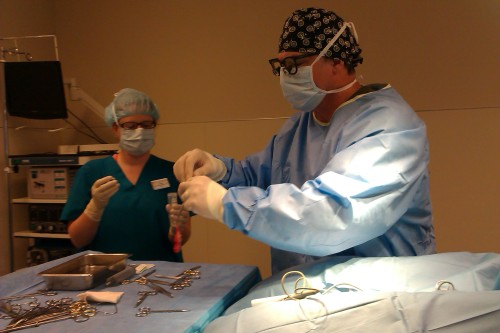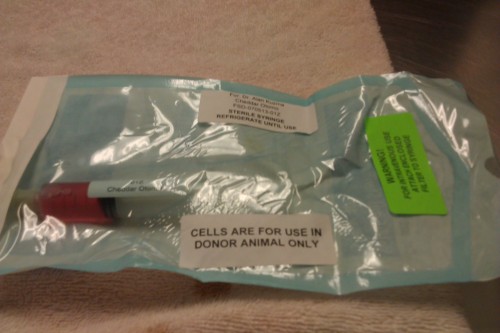Adipose Derived Adult Mesenchymal Stem Cell Therapy for IBD in an Adult Cat
 Saturday, December 28, 2013 at 04:01PM
Saturday, December 28, 2013 at 04:01PM Winner - Cases and Abstracts
Aki Otomo, St. George’s University
Cheddar is my 10 year-old Domestic Shorthair feline who I adopted in 2004 after he had sustained severe sacro-iliac trauma from being hit by a car at the age of 14 months. He initially presented with a necrotic tail pull injury, which required a short tail amputation with extensive urinary catheterization post-operatively.
By the age of 4 years, Cheddar exhibited numerous neurogenic issues including constipation, megacolon, urine retention from detrusor areflexia and fecal incontinence with pudendal nerve impingement. In 2011 his megacolon had progressed to a point where a subtotal colectomy was necessary. Subsequent sequelae included surgical dehiscience and septic peritonitis. In addition, his bladder atony became so severe he required a permanent low profile cystostomy tube for 14 months. Chiropractic adjustment, low level laser therapy and acupuncture allowed the removal of the cystostomy tube due to increased conscious voiding on Cheddar’s part, however he retains approximately 35mL of urine post-void. He currently suffers from chronic ascending multi-drug resistant urinary tract infections.
In December 2012, he was diagnosed with Inflammatory Bowel Disease (lymphactyic plasmacytic) with minimal villous lymphangiectasia and chronic mild gastritis. Initial therapy with diet change and Budesonide proved unsuccessful as his cachexia, weight loss and vomiting continued. Further Prednisone therapy resulted in a bladder wall fistula at his previous bladder pexy surgical site. Therefore, systemic immuno-supressants and steroids were ruled out as an ongoing treatment option for his IBD. After consulting with both his Internist Dr. Katie Baxter (BVSc, ACVIM) and Surgeon Dr. Alan Kuzma (DVM, ACVS), in July 2013, we enrolled Cheddar in Vet Stem’s IBD Developmental Program to use adipose derived adult mesenchymal stem cell therapy to potentially treat his IBD.
Background
Stem cell therapy is a fairly new form of treatment for a variety of diseases. Current clinical data has proven stem cell therapy to be effective for treatment of certain cases of equine osteoarthiritis, degenerative joint disease, osteochondrosis dissecans, ligament and tendon injuries, sub-chondral bone cysts, meniscal injuries and fractures (Nixon et al., 2008). In feline and canine patients, it is used most often for osteoarthirits (Black et al., 2007 and Black et al., 2008), orthopedic soft tissue injury, polyarthiritis and fractures. Although the complete understanding of the physiological mechanisms of stem cells have yet to be completely elucidated, stem cells are thought to promote healing and decrease inflammation and modulate inflammatory immune responses (De La Garza Rodea, 2011). They have the ability to modulate and control inflammatory cytokines and target areas of chronic inflammation (Fiorina et al., 2009) where they can potentially ‘re-set’ the inflammatory response through regeneration of normal cells and cell function (Zuk et al., 2002). Therefore, there is wide spread interest in researching stem cells to cure autoimmune diseases and disorders (Zuk et al., 2001).
Currently, there are various clinical trials being conducted on the use of stem cell therapy in felines with chronic renal disease with one such high profile trial being conducted at the Animal Medical Center in New York. However, the use of stem cell therapy for feline IBD remains controversial with only one clinical study having been conducted by Colorado State University in conjunction with the Winn Feline Foundation in February 2013. If adipose derived adult mesenchymal stem cell therapy for curing feline IBD can be proven to be effective, stem cell therapy could offer an additional option to the current standard therapy of diet change and immunosuppression. In addition, if stem cell therapy can actually cure IBD, the long-term use of steroids and their subsequent side effects and secondary diseases can be completely avoided providing a permanent cure solution as opposed to simply attempting to control and slow the progression of the disease.
Physical Exam
Cheddar was admitted on July 4th for stem cell harvesting under general anesthesia. Cheddar scored 2.5/5 on the BCS at 3.4 kg and was deemed slim with no palpable fat and marked muscle wasting with a MCS of 2/5. Physical exam yielded no other remarkable abnormalities.
Diagnostics and Imaging
Previous CBC and Chemistry panel conducted for pre-anesthetic screening were both normal with the exception of a low normal hematocrit of 30% (ref. range 29-48%). Urinalysis showed chronic bacteriuria as expected. Abdominal U/S was unremarkable other than mild thickening of the small intestines due to IBD. The previous bladder wall fistula appeared to be fully healed, and both bladder pexy sites remain permanent.
Treatment
General anesthesia was induced in order to harvest the adipose tissue for stem cell extraction and further culturing. Due to the overall lack of body fat and previous multiple laparotomies, the falciform ligament (a common fat collection site) could not be utilized. Therefore, an inguinal approach was made in the right inguinal region, where 9 g of adipose tissue was collected and submitted to Vet Stem’s laboratory in California (Figure 1).
The initial collection yielded a single dose of 7.925 million viable adult stem cells, which Vet Stem shipped back for intravenous injection. Vet Stem cultured 4 additional banked doses as well as retention samples to ensure a life- time supply of stem cells. On July 11th, Cheddar was injected intravenously with a single dose of 7.925 million stem cells. 14 days later he was given another intravenous dose of approximately 10 million stem cells that were cultured from the retention sample. 3mL of blood serum collected from the patient was used to thaw the stem cells and each dose of intravenous use stem cells was 5mL in total volume (Figure 2). Each 5 mL dose was slowly infused via a 22 gauge intravenous catheter placed in the cephalic vein over 5 minutes as per Vet Stem’s instructions (Figure 3).
Enrollment in Vet Stem’s IBD Developmental Program involved a pre-treatment questionnaire for both the client as well as the attending veterinarian that outlined body condition, quality of life, concomitant diseases, current medications and behavior of the patient. Post-treatment questionnaires were also required, asking similar questions 60-90 days post-injection in addition to gauging patient response and an opinion section that asked whether the client and veterinarian would recommend stem cell therapy for IBD based on Cheddar’s response. Client response sheets and veterinarian response sheets were completed separately and both were submitted to Vet Stem for review as potential data.
Patient Outcome
On September 26th, approximately 60 days post injection, Cheddar was weighed and an increase of 100g in body mass was observed (from 3.4kg to 3.5kg). Vomiting frequency was noted to have decreased from every 48 hours to approximately once a week. Stool quality remained unchanged however, which is attributed to the subtotal colectomy and will most likely remain for the rest of his life. 60 day post-injection CBC and Chemistry panel were normal, other than a mildly elevated platelet count with a normal hematocrit.
Case Review and Discussion
Cheddar’s improvement though mild and not completely cured of his IBD poses interesting questions in regards to the utilization of stem cells to treat IBD. I plan to inject him with an additional 2 doses to determine whether we can achieve an even greater response. As there are currently no standard protocols that exist to guide us as to how many injections of what number of stem cells at what interval should be administered, we hope to treat Cheddar with stem cells based on his response to treatment. Cheddar will be weighed routinely and his quality of life including frequency of vomiting, and general malaise and discontent will be considered in determining further treatment.
Adipose derived adult mesenchymal stem cell therapy for IBD is a novel and still fairly un-researched treatment option. When conventional therapies are not warranted for a certain patient with IBD, stem cell therapy may prove to be a valuable adjunct therapy. Cost as well as the experimental aspect of stem cell therapy for IBD continues to be the limiting factor for widespread use, and it is hard for companies such as Vet Stem to acquire data without research funding if clients are reluctant to pursue stem cell therapy. Further investigation and research is necessary and Vet Stem’s IBD Developmental Program is attempting to collect baseline data in order to gauge viability to conduct a more thorough clinical trial.
This case highlights the importance of trying new potentially beneficial therapies, when conventional therapies cannot be utilized. Veterinary medicine continues to be an ever-expanding discipline with ongoing research and clinical studies being conducted in order to implement cutting edge novel technology, techniques and medicine in order to treat patients and mitigate their diseases. Stem cell therapy in the future could very well be a viable treatment option for a variety of diseases once further research on its efficacy and viability has been conducted.
References:
Black L, Gaynor J, Gahring D, Adams C. 2007. Effect of Adipose-Derived Mesenchymal Stem and Regenerative Cells on Lameness in Dogs with Chronic Osteoarthritis of the Coxofemoral Joints: A Randomized, Double-Blinded, Multicenter, Controlled Trial. Veterinary Therapeutics. 8(4): 272-284.
Black L, Gaynor J, Adams C, Dhupa S, Sams AE. 2008. Effect of Intraarticular Injection of Autologous Adipose-Derived Mesenchymal Stem and Regenerative Cells on Clinical Signs of Chronic Osteoarthritis of the Elbow Joint in Dogs. Veterinary Therapeutics. 9(3): 192-200.
De La Garza-Rodea AS. 2011. Myogenic properties of human mesenchymal stem cells derived from three different sources. Cell Transplant. Pub Med.
Fiorina P, Jurewicz J, Augello A, Vergani A, Dada S, et al. 2009. Immunomodulatory Function of Bone Marrow-Derived Mesenchymal Stem Cells in Experimental Autoimmune Type 1 Diabetes. The Journal of Immunology. 183: 993-1004.
Nixon A. 2008. Effect of adipose-derived nucleated cell fractions on tendon repair in horses with collagenase-induced tendinitis. AJVR. 69(7): 928-937
Zuk PA, Zhu M, Ashjian P, et al. 2002. Human Adipose Tissue Is a Source of Multipotent Stem Cells. Molecular Biology of the Cell. 13:4279.
Zuk PA, Zhu M, Mizuno H, et al. 2001. Multilineage cells from human adipose tissue: implications for cell based therapies. Tissue Engineering. 7(2): 211.
Figures:

Figure 1: Surgical harvesting of adipose tissue.

Figure 2: Single dose of intravenous use mesenchymal stem cells.
 St. George's University,
St. George's University,  neurology in
neurology in  Cases/Abstracts
Cases/Abstracts 